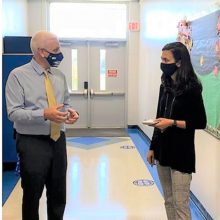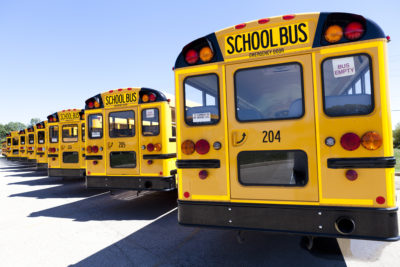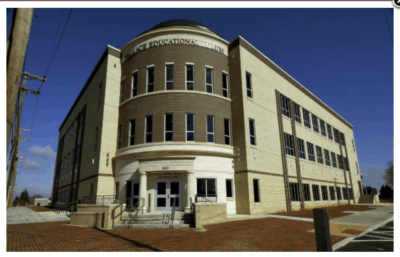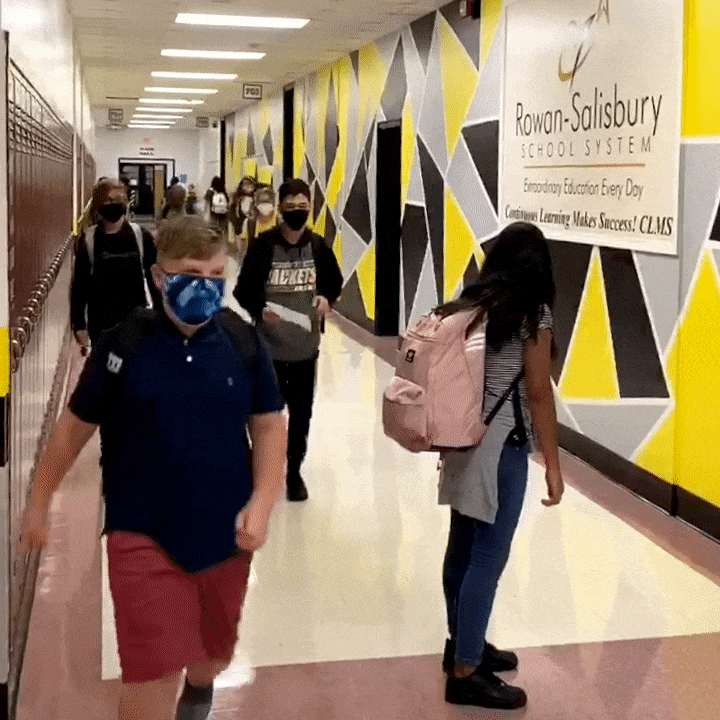

Lynn Moody has been a superintendent for almost 15 years. The most difficult recommendation she’s made to a school board came this summer when she recommended that Rowan-Salisbury Schools (RSS) open under plan B.
The district has had a strong one-to-one technology program in place for years, meaning every student has a dedicated device. That made people question why they would decide to reopen school buildings.
“Our answer was that we really truly believe that children learn best with human connections. It’s best at the end of the day,” said Moody during a virtual back-to-school update on Aug. 25.
North Carolina school districts were given two options for reopening this school year — plan B, which brings students back to classrooms under strict safety guidelines and generally includes some remote learning, or plan C, which is only remote learning. Roughly 70 of the state’s 115 school districts chose plan C, while the others have brought students back to the school building in some form or fashion.
Rowan-Salisbury’s virtual back-to-school update included a variety of elected officials and representatives from the State Board of Education and the Department of Public Instruction (DPI). It intended to provide insight into how Rowan-Salisbury Schools has operated under plan B.
“We are hoping to be able to show not only community members but also those around the state, what does a plan B look like?” said Freebird McKinney, legislative director of government and community relations for the State Board. “We want … to see … what it takes to do that successfully, keeping in mind health and safety guidelines.”
Click here to watch a safety precautions video that Moody filmed.
Physical spaces
Under plan B, RSS students are split into two groups — group A and group B, with approximately 50% of students physically in facilities at one time. Students attend school in person two days a week while the other three days are remote, and Wednesdays are used for cleaning.
Physical spaces across the district have been adapted, including by repositioning desks to maintain six feet, adding directional signs in hallways, installing plexiglass barriers, and replacing water fountains with water bottle filling stations. Where possible, the district has increased the fresh air intake of HVAC systems, and maintenance staff are changing out air filters more frequently.
Anthony Vann, associate superintendent of operations, said two main challenges have arisen. One is difficulty securing the necessary products to make indoor spaces safer, including plexiglass, HVAC filters, and water bottle filling stations. Another challenge is securing the workforce needed to install these products and sanitize facilities.
Vann also said that outdoor learning spaces are more important than ever, and the district is working to install more of those spaces with the help of community organizations like the Boy Scouts. Moody added that elementary teachers have asked students to bring beach towels for use in outdoor learning spaces — which provides an easy, cost-effective way to teach them outside while maintaining social distance.
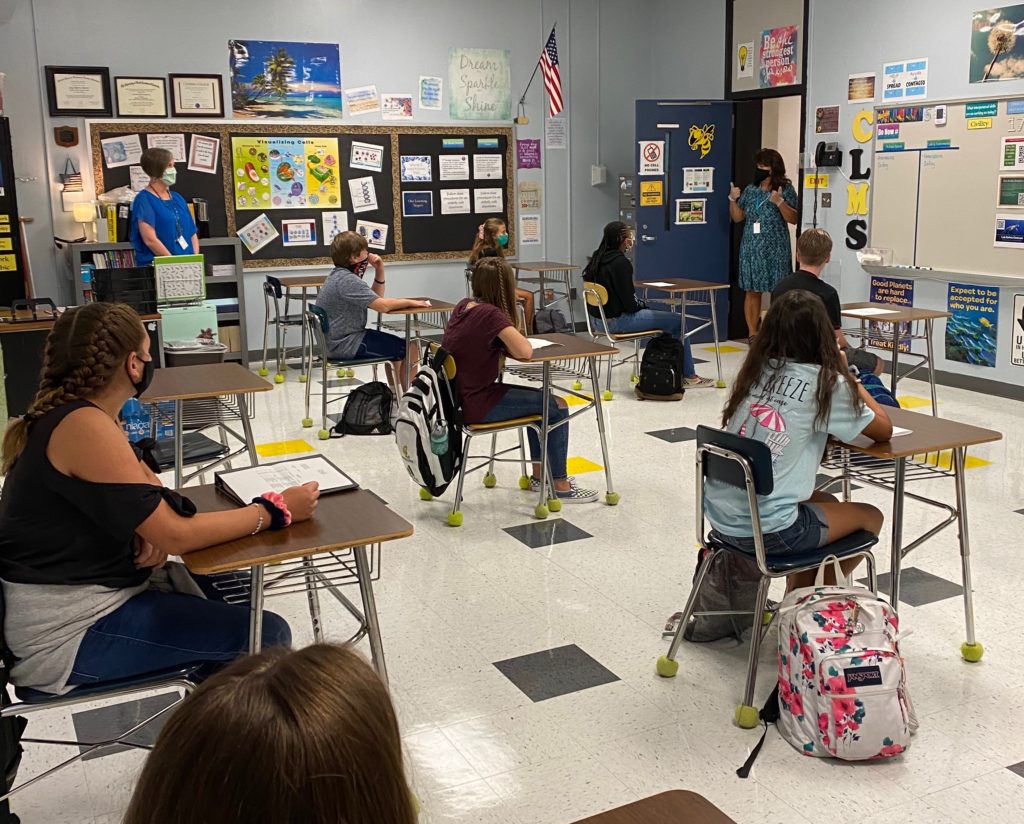

Transportation
Tim Beck, director of transportation, said he had concerns since his team had such a short amount of time to create bus routes that they usually spend all summer creating — but things have gone surprisingly well.
RSS is currently running all 180 of its yellow school buses and four of its 12-passenger vans. Current state guidelines allow for 24 students per bus, and masks are required before a student can board. Beck said picking up students has slowed routes down slightly since those without masks are given a disposable one to put on before boarding.
Overall bus ridership is down from previous years, and the district asked the community to help their students find alternative methods of transportation in order to meet the reduced capacity requirements.
Due to the condensed timeline to sign up for bus transportation, many families missed the deadline, so the district is continuously adding students to bus routes. As numbers increase, there is a chance that additional bus routes will have to be added if the 24 person maximum is exceeded — which would require buses to double-back for a second round of students after their first route.
Beck said the district currently has enough bus drivers to staff the routes, but training them on how to properly sanitize the bus has been a learning curve.
Nutrition
Even after school buildings closed in March, RSS continued providing meals to students using school buses. When plan B was announced, Lisa Altmann, director of school nutrition, pulled her nutrition managers together to brainstorm where, when, and how students would receive meals safely while in school.
Now, many schools are having meals delivered from the cafeteria directly to the classroom. Altmann said that was made possible by equipment purchased using CARES Act funding.
Some schools also have kiosks at entry points for breakfast. At others, students come through the cafeteria line and take meals back to their classroom.
Altmann said it has been a challenge to figure out how to provide meals to those in the district’s virtual academy. Six schools are operating as meal distribution hubs, but not many people are taking advantage of that service.
“Several parents are saying it’s too difficult for them to leave their homes,” said Altmann. “So at some point we’re going to have to address how to better serve those students.”
Another challenge is that on August 31, the ability to provide free meals to all students will end as a federal waiver expires. That means students will have to be logged as free, reduced-price, or paid. Meals are provided for the days that group A and B students are learning from home, and Altmann said that will become even more challenging when students have to pay for those meals.
Nurses
Rowan-Salisbury Schools has 14 school nurses, each of whom is assigned to 2-3 schools.
“This is not ideal under normal circumstances, but definitely not under COVID-19,” said Carol Ann Houpe, director of student services.
To address that, the district added three temporary school nurse positions, which will ensure each nurse is assigned to two schools. Since there’s not a nurse in every building at all times, Houpe said there had to be a COVID-19 designee for each school for when the nurse is not present.
“As we developed plan B, it became more and more challenging for schools to identify a designee with existing staff. So we hired 17 temporary health room assistants,” said Houpe.
These assistants are also assigned to two schools and work closely with the school nurse to provide health services, like screenings and temperature checks. Students are also required to complete a daily COVID-19 screening form.
All schools also have an isolation room for students who show symptoms. The nurse or health room assistant monitors students while they are there.
As of Aug. 28, Rowan County was reporting 2,712 total COVID-19 cases with 62 deaths. The percent of positive tests was 9.09%. According to the Salisbury Post, a handful of students and staff have tested positive, but the district has not had to close any schools.
A look inside schools
The event also included virtual “visits” to three different schools across the district where administrators, teachers, and students provided insight on their experience under plan B.
At China Grove Elementary, Principal Lea Anne Thomas showed social distancing stickers that have been placed on the floor outside of classrooms. She also held up a lanyard button that teachers are wearing that show a smiling head shot so students can see what they look like without a mask on.
At West Rowan Middle, Angelica Bautista, an eighth grade student, shared reflections on coming to school under plan B.
“It really hasn’t been that bad coming back to school during plan B. I admit that wearing a mask all day is hard. I also miss seeing my friends’ and teachers’ smiling faces,” said Bautista. “But I know that this is the safest way. It’s safe for me and also safe for others to be six feet apart and wear masks.”
At East Rowan High, two seniors shared their reasons for deciding to come back to school in person, including wanting to see their friends and teachers and wanting to participate in extracurricular activities such as band.
Courtney, a senior, is thankful for the in-person option. “I went to school today, and I was super excited. I’m ready to just go and conquer.” pic.twitter.com/DEjptZfNgW
— Mebane Rash (@Mebane_Rash) August 20, 2020
The principal of the new Summit K-8 Virtual Academy, Amy Pruitt, also provided updates. Pruitt said students have access to their learning at their own pace throughout the day and their parents can work with them according to their schedule.
In her closing remarks, Moody reflected on the Friday before the first day of school, when she said she was close to having a nervous breakdown. Then, Monday morning came, and it was “the most beautiful thing I’ve ever witnessed in my lifetime of education.”
“It has been worth all the planning, all the nightmares, all the headaches, all the confusion,” said Moody.
